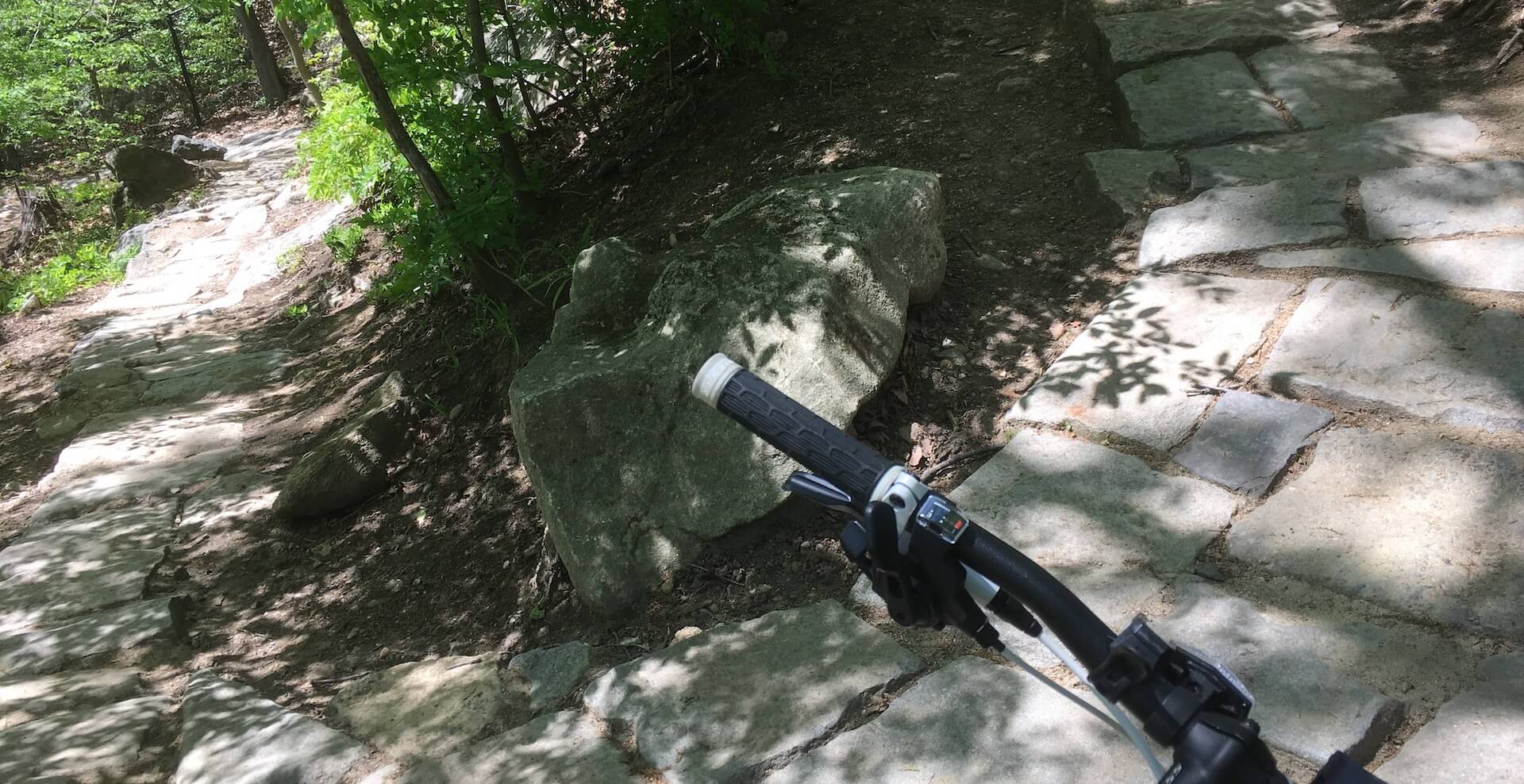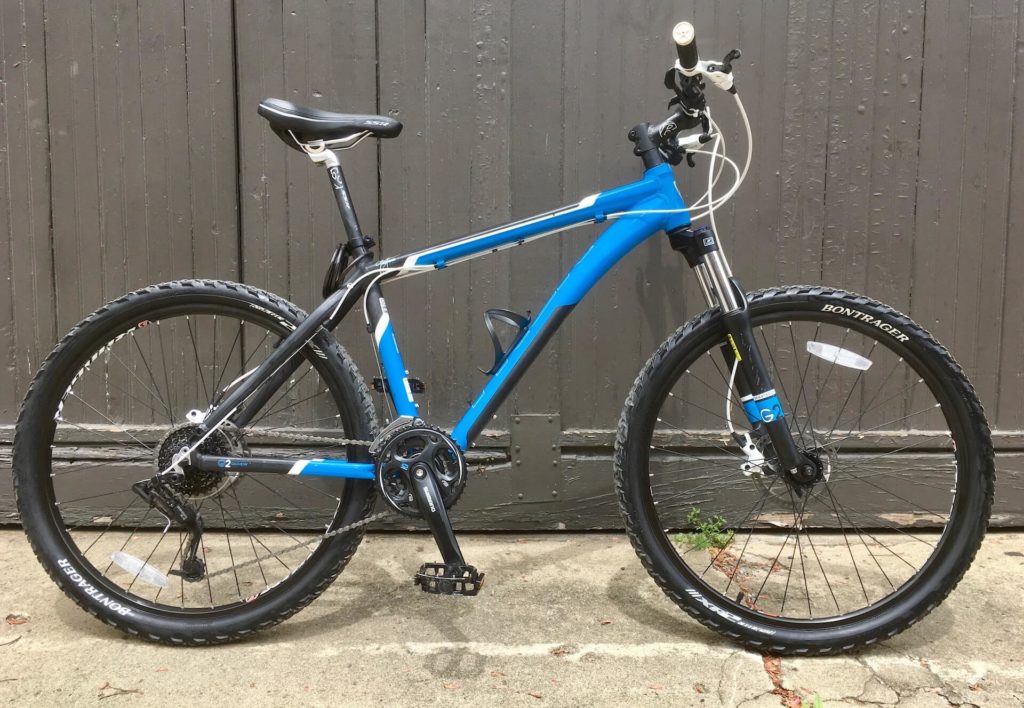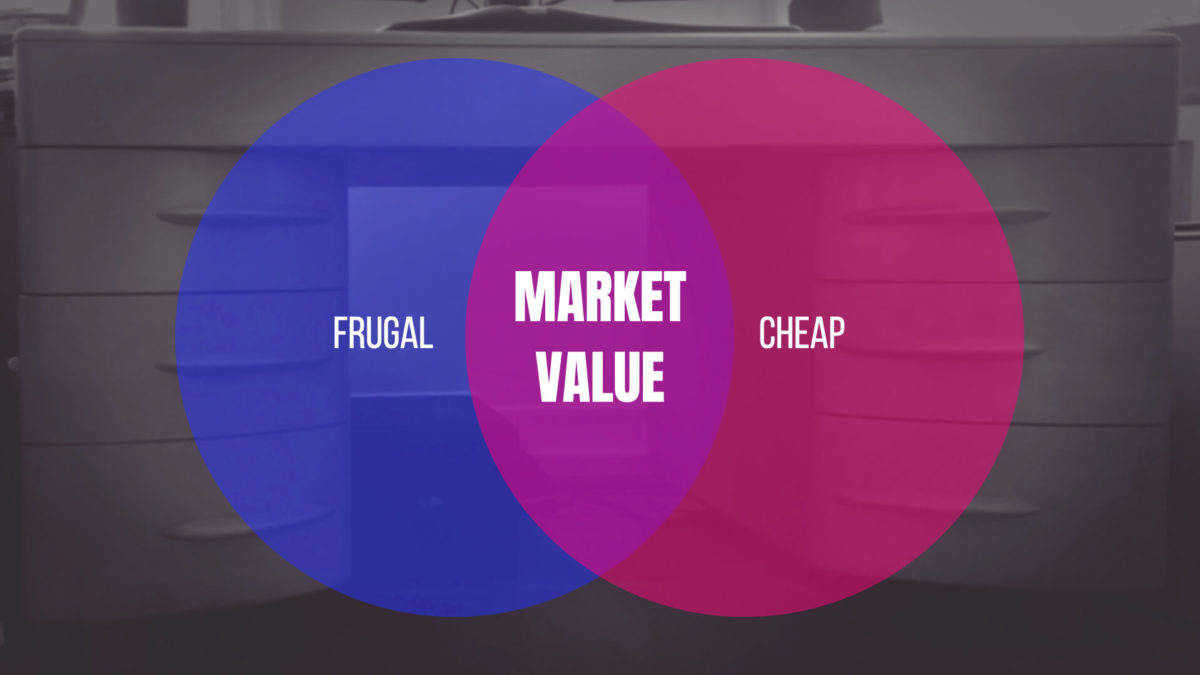The keyboard I’m clacking away on sits atop a mid-century Heywood-Wakefield kneehole desk. I bought it for a frugal $252.63 in 2018 at a local auction. It exemplifies my personal experience with the difference between frugal and cheap. At the time, I’d been shopping for an office desk, on and off, since 2013. Let’s take a look at this anecdote to explore the question: “cheap vs frugal: what’s the difference?”
In the meantime, I was struggling with a cheap multi-level black pressed particle board and glass wobbling monstrosity from a big box office supply store. I’d purchased it only a few years earlier. The plastic “wood grain” veneer was already peeling up off the particle board in spots. The hefty 30″ LCD I used with my workstation caused the upper-level platform to wobble so badly when moving the desk whatsoever—naturally, on plastic wheels. I was afraid the monitor would topple over and crush more than a toe one day.
I got a cheap desk—for cheap. On sale, I managed to snap it up for $50. After an hour of putting it together from the flatpack it came in, it worked just fine for a year. That’s before mild wear and tear loosened the numerous screws. Little movements were enough to start stripping the particleboard drill holes and kick off the wobbly desk dance.
I’d suffered the lure of cheap due to still being in an early step to financial freedom. I didn’t yet understand the value of quality over cheapness.
But, hey, it was cheap.
Once that Heywood-Wakefield desk made itself at home under my keyboard, the old black wobbler found its way to a new owner. I let it go for a tenner on Craigslist. I’d suffered a $40 net loss and a frustrating handful of years with wobbly desk syndrome. Sure, it held my workstation off the ground during that time. That’s about all it did. A couple of cinder blocks and a board wouldn’t have made me think we actually lived atop California’s Big One epicenter every time I dared breath in the general direction of my desk. But, hey—it was cheap.
What’s the Difference Between Frugal and Cheap?
You may be thinking: “Well, okay, one is a cheap desk that falls apart after some years. The other is an expensive desk that will last longer. But you paid six times the price for it!”
You’d be right. Let us set aside the fact that there’s a tragedy of the commons when it comes to mass-produced throwaway junk polluting landfills. We’ll ignore the irritation I had with the wobbling wonder, minor as it may be in the grand scheme of things. There is one key aspect that sets the two purchases apart which has been ignored so far, though. That is the market value of the Heywood-Wakefield Kneehole desk that’s decades old.
As the embedded Antiques Roadshow clip above shows, whenever I decide to sell the desk, it should return a multiple of what I paid for it. I just need to keep it in reasonably good condition. This desk’s market value has increased over the decades due to a combination of inflation, lasting construction, and general desirability. There’s no reason to believe that market value will go down in the near future. The absolute price I paid is generally irrelevant.
Qualities of a cheap person and how to be frugal
As an example, these are qualities of a cheap person or cheapskate:
- Drives an unsafe vehicle and skirts safety inspections by bribing the inspector
- Buys a car with “no money down” and a very long debt payback period
- Aims to pay the lowest cost per calorie for groceries
- Intentionally shows up late to social gatherings at restaurants to avoid buying expensive meals out but eats other’s leftovers
Often this person comes off as stingy, unwilling to spend money even where it makes sense to. A cheap person’s only concerns are the absolute cost without considering the value received from spending money.
Meanwhile, a frugal person would take a different approach. Here’s how to be frugal but not cheap in the same scenarios:
- Purchases a used vehicle to mitigate depreciation with a certified safety inspection
- Makes large purchases by paying in full to avoid high debt interest rates
- Buys off-brand groceries to save money and focuses on nutritional & health value per dollar
- Suggests having social gatherings as a potluck at their place instead of a restaurant to save money but build healthy social relationships
Frugality is a focus on overall value, accounting for more than just the absolute price of an experience, service, or product. A cheapskate is solely concerned with the specific and immediate cost.
Good value + (purchase price < market price) = frugal purchase
A key component of the difference between cheap and frugal is value. It’s not necessarily quality—which is certainly nice, but quality can be neither frugal nor cheap. A frugal purchase, or good value purchase, is derived from the price you pay relative to its market value. It should also be of significant use to you: not destined to wind up in a landfill anytime soon. In sum, a low purchase price compared to market price added to high, lasting usefulness to you—defines frugality.
Part of our choice of city life vs country life was analyzing the total value of each housing choice for our personal situation. While buying a place in the country would have been cheaper in terms of the mortgage itself, it would have meant more driving and less walking for us. We also benefit from more free entertainment, culture, and city events.
Fancy stuff and expensive hobbies
This mentality lets us fill our house and our lives with some high-end objects. We have a teak dining set by J.L. Møller that will outlast both of us. It’ll do so while increasing in value, making it more of an investment than a furnishing cost. Buying it for $933.55 when the local market value exceeds $2,000 makes it frugal. Our Danish designed tabletop cabinet just found a new home as a gift for a very happy wife. The husband gleefully picked it up from us for $295. It’d served as an organizer for nearly two years for us. At a cost of $83.38, it was a solid money maker.
Careful shopping lets us “rent” many things we’d simply like to test within our lives. Thinking about selling a thing, when we buy it, helps us avoid immediate depreciation from new things. We don’t feel guilt from the expense itself or feel limited by the inherent traits of a FIRE budget.
Cheap vs Frugal in Hobbies

Last fall, I started getting into mountain biking. We live within a 10 minute ride of a solid 15-20 miles of riverside mountain biking trails. I’ve carefully biked through the connecting fire roads—and even occasionally on the actual MTB trails—with a hybrid bike. I wanted to take it up a notch.
My research showed mountain biking could wind up being a very expensive hobby. Buying a new $2,000 hardtail bike seemed crazy, just coming to the sport. I found a gently used 2012 Trek 29er with disc brakes and front suspension that needed a minor repair. After $100 for the bike and $30 part, I was zipping around the MTB trails for the season. My amateur skill wouldn’t notice the difference between the high-end, new hardtail. The 90%+ cost savings sure was noticeable, though.
I loved the rush and was getting more comfortable in technical sections every time I repeated a route. I rarely saw someone else on the trails-which isn’t too surprising when it’s 2 pm on a Tuesday. Everyone else is toiling away at the office. After the season, I decided I got a good enough feel for the sport. I figured I might have a sudden stop with a tree at some point, too. I needed a biking partner to safely keep this up and I didn’t have one.

It was time to find the Trek a new home. With the season over, lots of other folks were offloading their bikes on local marketplaces. With plenty of savings and no budget needs, I was in no rush to sell the bike quickly. I waited until the start of the next biking season. With Spring in full bloom, the bike sold quickly once posted for sale at a competitive price of $290.
The alternative cheap choice would have been to buy a mountain bike made by Huffy, Schwinn, or Hyper from Walmart. I could have had one for $100-200 the day I was ready to make the purchase. I wouldn’t have needed to be patient going cheap vs frugal. But, I’d have been riding a bike that wouldn’t retain its initial value (take a look at secondhand prices for those brands), while having a worse riding experience. Many experienced riders would even suggest they’re less safe.
Cheap vs Frugal: Price Paid is the Key Difference
That’s not to say these “investment” purchases or “rental” periods always work out profitably. Occasionally we’ll wind up with something we break, lose, or otherwise destroy the value of. Some things are simply hard to sell used—though I did once sell a toothbrush for a profit. Significant research to identify what purchase within a given hobby or interest that can hold its value is often required. It also takes patience to wait for a good deal and even more for a profitable sale on the other side.
When comparing the differences between frugal vs cheap, cheap is fast, and short term. Frugal is methodical and long term.
The point is that frugal decisions and careful planning can allow you to fit high-quality, high-priced stuff into a FIRE philosophy. FIRE is all too often tied to being cheap. Really, core tenants are more compatible with value orientation and frugality. The more expensive item, in absolute terms, can sometimes provide a better experience while you have it. Simultaneously, it can offer a profitable return when you’re done with it. This works when you have the extra funds available to make the initial purchase. Having extra funds for investments is a natural part of being on the road to FIRE.
Of course, the most frugal purchase of all is to buy nothing. That may be a reasonable goal, but most of us aren’t ascetics.
If you can consistently churn those frugal purchases through an appropriate market for them, powering your plan for financial independence, you might consider a mental trick of mine. It’s the idea that “everything is for sale”—a way to capture expected future value, which I’ve touched on throughout this post. It’ll let you turn your frugal mindset into a profit machine.
Where do you think it makes sense to be cheap vs frugal?
Let us know in the comments or on Twitter!


12 replies on “Cheap vs Frugal: Surprising Differences (Find Your Frugality)”
I also subscribe to this idea of “renting” things through careful purchase of secondhand quality items with consideration for potential resale later. Secondhand items have already gone through the quick value drop of depreciation from when the original purchaser bought them new, yet will often hold value near that same secondhand price. In this way, I recently “rented” a standing desk by buying it used for $45, then selling it again a few months later when I no longer needed it for $90 (with the new buyer still getting a great deal down from $180 new).
Frugality to me is about using resources efficiently for the most value. That can also be the resource of time and energy. If it is going to prove genuinely too stressful or taxing to wait for the perfect item at the perfect low price, I also know when to be flexible to take alternatives or accept paying slightly more.
There is a touch of minimalism in here, where you shouldn’t be too attached to your possessions. Having the idea that “everything is for sale” and also replaceable, this can be freeing and a good way of getting clearer on what truly matters.
Great post! I look forward to reading more of your work, Chris.
Thank you Michelle for reading our post. We are excited to have our first comment as we start our new site. We definitely agree that we have a touch of minimalism although not to any extreme. “Renting” is definitely a nice way to try things out then pass them on when its time. We often do this with electronics like TVs and cell phones as well. It helps keeps the costs down when upgrading or even getting a return on the investment. We look forward to getting more posts up soon and will have to check out how FI works for you across the globe in Australia.
Great post. I agree that FI should not be about being cheap, there is a clear difference between price and value and determining the difference is key.
We are not as bad ass as you at selling things on for a profit but have done plenty of buying /selling where the losses are minimised, making it seem like you’ve practically had use of the item for free when you consider length of service.
Of course there are some items this is not possible on, tech, white goods, etc…
I would love to know how you managed to sell a toothbrush on for a profit?! 🙂
Thanks for the kind comments and again congrats on the recent big announcement!
Ha, the toothbrush! Not too complicated: occasionally the baseline Oral-B electric toothbrush would go on sale for $21.03 after tax on Amazon (I was watching it with CamelCamelCamel and seeing deal alerts on Slickdeals) with additional promotions. I was dissatisfied with the Sonicare I bought late 2016 to replace an aging (gifted) Oral-B. So, in early 2017 when the right promo combo hit on Amazon, I snapped up that Oral-B for $21.03. The Sonicare hadn’t been in use for very long. The charging base was in great shape and the handle didn’t have a mark on it. The Sonicare uses a larger brush head that includes part of the top of what most people would think of the toothbrush section which I thought might make it easier to sell. I listed the charging base and toothbrush handle separately on eBay as lightly used.
I just pulled up the PayPal receipts: $11.95 for the base and $15.95 for the handle. Net $27.90. Subtract ~13% in fees = $24.27. First class shipping was still inexpensive in 2017, under $2 for each small package. It might have been a tiny loss in the end due to sales tax, but close enough! 🙂
I liked this article. We gave up on particle board furniture long ago. They tend not to survive more than one move before they become loose and wobbly. In any case frugal is much different than cheap. You get what you pay for.
Thanks for stopping by! Yep, most of the particleboard flatpack furniture really is made to be set up once and not moved again. I somehow managed to get that desk to at least survive a few moves.
I used cardboard to make furniture for the first few years living on my own. Not really for any specific money saving, but because it was nice to be able to make exactly what I want. I used a lazy Susan and the box from a sound bar which was a very unique shape. The lazy Susan I attached to the bottom of the box and set it next to my bed. The box had a very long section that stuck out, but wasn’t very tall. So I would spin the box and have that part under the bed frame. When I was playing video games or watching TV, I would spin the box out so the long part was exposed and I had a place to set drinks and food without worrying about it spilling on the top, where I had cut a slit and run chargers through.
I also built shelves with cardboard. Book cases. And even a wine rack using a produce box from Aldi and some twine. Held 4 bottles of wine, 4 wine glasses, the corkscrew and 2 stoppers.
A coating of plastidip and some spray paint if necessary and the boxes were about as good as the particle board stuff you’d buy at the store. Better maybe, because they didn’t bubble up or peel apart from setting cold drinks on them
Not to mention, you found yourself a bit of a DIY hobby! That in itself has tremendous value (after all, we have to spend our time somehow!). I can remember building a swamp cooler with a crazy DIY particleboard contraption when my car in college no longer had working AC. Virginia heat is pretty killer in summer! There’s certainly lots of fun things that can be done with cheap materials.
Cool! Thanks for sharing.
Congrats on the new site it looks like your already making a splash! That toothbrush story may have stole the show! 😉 Cheap things have the habit of ending being thrown away in a more cavalier way versus items that have a higher upfront cost. Cheap fashion, fast food, and other meccas of “fast” waste seem to be directly linked to wasted cash. Perhaps its more correlation than causation.
Thanks! Jenni and I have been having lots of fun coming up with good reads and fun topics to write about around here!
It’s amazing how even a little toothbrush wheeling-and-dealing can build up that Frugality Muscle 🙂
Speaking of waste… we have a big Guest feature coming on JUST that topic! Can’t wait to share it. Stay tuned!
There is a problem with your approach – your nice stuff owns you instead of you owning stuff.
You spent from 2013 to 2018 shopping for a desk? That’s 5 years of thinking about an office desk. Why would you do that? You could’ve just bought slightly better cheap desk for $100 and use it for the rest of your life or until you move out or whatever. Instead the office desk purchase was a thing in your mind for 5 years. That’s just waste of life energy on things.
After 5 years of shopping (checking classifieds, garage sales, occasional conversations about buying a nice desk) you paid a good bit of money for an office desk. You even know the brand name of your office desk, you brag about this brand name in your post above! You proudly announce how good a deal you got and how well you can sell it. You’re just owned by this stuff and it defines you.
But that’s just a beginning of the problems. Now you have this nice desk got at a bargain price with the vision of getting your money back when you one day sell it. You have to keep it in “reasonable condition”. Again your stuff owns you.
One day your kids damage slightly the top of your nice desk. You’re not happy about it. Another day your wife does her nails on your nice desk and spills a bit of varnish remover on it. Damages the lacquer a bit. You’re not happy about it, that’s your nice stuff with resale value and price tag in your mind. The stuff that owns you.
One day you’ll be moving houses. Now your nice stuff has to be carefully protected and packaged to preserve the resale value you have in your mind. Alternatively you can sell it before the move – list it somewhere, find the buyer, negotiate the price. Now count how much time you spent with your mind occupied by your desk – finding good deal, protecting it, maybe maintaining it, moving it, selling, talking about it and blogging about it.
And this is only your desk. You mentioned other “nice” things surrounding you. Nice things that own and define you. Things with brand names and price tags you still remember.
That’s just stuff.
I’d take cheap any time. The more replaceable and disposable the better. This is just stuff. I buy it without thinking twice, as long as it’s good enough to serve the purpose and cheap. I throw it away or drop off at Goodwill once not useful anymore. I don’t remember the brand name, price or model, never thought twice about it.
Couple of years ago I moved from Europe to US. Great I didn’t have any “nice stuff”. We just posted few boxes of things over and threw away the rest. We didn’t think twice of what to sell, for how much, what to pack carefully to preserve it’s resale value etc. Dealing with our stuff took us probably 2 hours of dropping stuff outside the house so that it can be collected by charity shop team.
That’s freedom of being cheap.
Hey Bob! Thanks for taking the time to write a very thoughtful comment.
I don’t generally disagree with what you’ve written and I think it makes a great counterpoint or alternative path for some folks.
Really, the only major issue I take with the “cheap” route you alluded to:
“I throw it away or drop off at Goodwill once not useful anymore.” (emphasis mine)
I’m pretty strongly opposed to material waste (although to your point, perhaps not mental waste!). In general, buying quality will prevent waste in the long term as we don’t tend to cycle through new things. That said, it may not be worth it for some people like yourself.
Lastly, I’d like to point out that while it did take some time for me to find a new desk, it was with the intention of making this purchase very rarely (and perhaps the last desk of my life if I can avoid all those kids and fingernail polish like you mentioned, though, we’re not exposed to either of those risks). Personally, I do feel it’s worth waiting to find the right one. To be clear, this wasn’t some sort of daily process. I dealt with the old desk as-is until the right deal came along. We filter for many different things we’re on the longterm hunt for, and a desk made it on that list. Once the right deal appeared (at an estate auction I was originally looking for something else in), I jumped on it.
Thanks for writing out a countervailing perspective, Bob.